April 12th, 2024
Part Five: Central Park as An Outdoor Museum
The Civil War greatly altered the social, economic, and cultural conditions of the nation. Hesitant at first and then with more assurance, sculptors continued to be influenced by the Beaux-Arts neoclassical aesthetic, and pragmatic, self-made supporters of public art in both the North and South funded monumental memorials of war heroes executed bronze. Schooled in Italy, contemporary sculptors learned to apply the classical poses they had learned from the marble Roman and Greek monuments of Antiquity to which they added the expressive plasticity of sculptures modeled expressively and then cast in bronze, which was then given a smooth surface enriched by a deep, rich golden-brown patina.
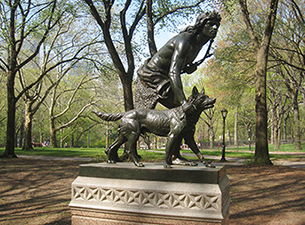
Indian Hunter by John Quincy Adams Ward
An early example of the vigorous realism these mid-nineteenth-century sculptors adopted can be found in John Quincy Adams Ward’s Indian Hunter. Unveiled in the park in 1869, it established Ward as the leading sculptor of mid-nineteenth century naturalism. Ward was subsequently commissioned to sculpt three other statues that were erected in Central Park:
1) A larger-than-life-size portrait of William Shakespeare, which was unveiled in 1872 at the south end of the Mall adjacent to Literary Walk. Here Ward’s compositional skill combines a classical pose with a studied, objective representation of Elizabethan dress flowing from the shoulders below a sculpted portrait of the sixteenth-century playwright and poet.
2) A bronze sculpture of a vigilant Union soldier representing the Seventh Regiment of New York City, an infantry unit made up of scions of New York’s socially elite families, Following the trend toward memorials of a patriotic nature, this sculpture honoring the fifty-eight New York City soldiers who were killed in World War I was erected in 1874 on a knoll above of the West Drive opposite 67th Street.
3) As an expression of upper-class Anglo-Saxon genealogical pride, the Pilgrim, which had been sponsored by a committee of the New England Society of the City of New York, was dedicated in 1885 as a proud remembrance of the Puritan settlers who landed on Plymouth Rock in 1620.
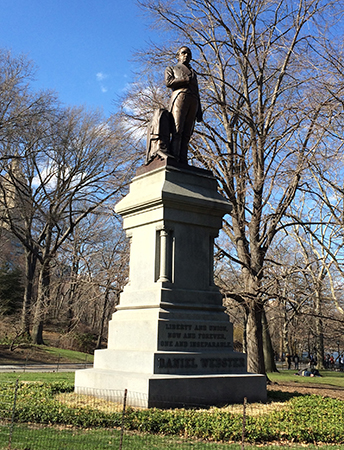
Daniel Webster by Thomas Ball
Celebrating America’s post-Civil War’s republican governance is a larger-than-life-size statue the lawyer and statesman Daniel Webster (1782–1852), whose gift for oratory championing the authority of the Constitution in preserving the Union made him a political icon in the North. The American sculptor Thomas Ball was thereby commissioned to recreate on a monumental scale the full-length portrait of the portly Webster he had previously modeled as a statuette, which was widely collected and displayed in the homes of Union supporters. The placement of the proposed fourteen-foot tall bronze memorial atop a 20-foot pedestal at the southern end of the Mall was opposed by the designers of the Central Park’s 1857 Greensward Plan, Frederick Law Olmsted and Calvert Vaux, on the grounds that this sculpture would be out of scale with the other monuments nearby. As a consequence, a site at the intersection of the West Drive and the 72nd Street Cross Drive was chosen for the Webster statue’s prominent individual display. Modeled in Ball’s studio in Florence and unveiled in Central Park in November 1876, the larger-than-life-size bronze figure in tight-fitting clothes is posed in a “Napoleonic” stance atop a twenty-four-foot granite base. From this memorial statue’s park-traffic-island setting it can best be viewed in its entirety from the hillside pathway leading to and from Strawberry Fields, the restored 2.5-acre park landscape that boasts the park’s unqualifiedly most revered memorial, which is not a sculpture but rather a ground-plane-level circular mosaic embedded in the pathway with no other design than the single word IMAGINE , the title with a repeated refrain at the beginning of each line of the Beatles rock music band member and lyricist John Lennon.
World War I, which again saw the bravery of the Seventh Regiment, honored its 107th infantry division in 1927 at a site on the outside perimeter of the park at Fifth Avenue and Sixty-seventh Street with Karl Ilava’s group memorial of six soldiers charging into battle, dramatically conveying the courage, horror, and pain of twentieth century warfare based on the efficiency of mechanized equipment. As an aside, World War I also fostered a proposal that would have inflicted an encroachment on the park’s naturalistic landscape when, as an inducement for civilians to purchase of war bonds, it was proposed to turn the Sheep Meadow into a replica of the site in France of the trenches dug for the protection of American soldiers in the bloody 1916 Battle of Verdun.
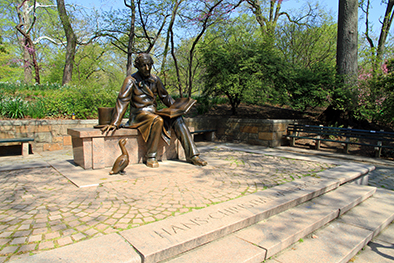
Hans Christian Anderson by George Lower
As opposed to the memorials commemorating wartime bravery, the post-Second World War years saw the park as a ready-made venue for artistic lightheartedness in the choice of characters from children’s books as ideal subjects for statuary. Pursuing the unfolding of this trend, we find a bronze figure of Danish author Hans Christian Andersen (1805–1875) by George Lober seated on a low wall beside the Model Boat Basin with a pretty young girl lying on her back across the centerfold of a wide open book balanced on the author’s left knee and a sculpture of “The Ugly Duckling,” one of the most memorable characters in Andersen’s 156 literary fairy tales, waddling along the stone terrace near the point where his right foot rests.
Nearby, north of the Model Boat Basin is the popular multi-figure sculpture of John Tenniel’s illustrations depicting the characters in Lewis Carrol’s Alice in Wonderland by José de Creft’s (1884–1984). The ingenious treatment of the statue’s masses and voids and the imaginative portrayal of Tenniel’s figures in bronze of the story’s characters, including the March Hare, the dormouse, a small crocodile, and the Mad Hatter with the facial features of the statue’s donor George Delacorte have made this charming work in Central Park’s collection of outdoor art a magnet for climbing children, eleven of whom were Delacort’s grandchildren, who unveiled the sculpture at its dedication in 1959.
_
In 1945, Sixth Ave was rechristened the “Avenue of the Americas” by New York Mayor Fiorello LaGuardia, who hoped the new name would draw South American businesses and consulates to the area. As a consequence the Sixth Avenue entrance to Central Park at Fifty-ninth Street was adorned with memorials of three South American heroes who were liberators from Spanish imperial rule: Simón Bolivar (Venezuela) by Sally James Franhamn and José de San Martín (Argentina and Peru) and José Martí (Cuba) by Anna Hyatt Huntington.
_
The Bethesda Terrace is not the only place within Central Park to boast a fountain. The six-acre Conservatory Garden, which is located in the north end of Central Park on the west side of Fifth Avenue and 104th Street, consists of an English-style garden and a French-style garden, between which, framed by twin allées of crabapple trees, a broad Italianate greensward leads the eye to a wisteria pergola atop a well-designed brick maintenance-equipment-storage building at its western end.
Designed in 1936, by Park Commissioner Robert Moses’s Chief Consulting Architect, Aymar Embury II (1880-1966), the Conservatory Garden’s subsequent dereliction was due to several years of poor maintenance by the Parks Department as well as the reputation of its location in the North End, which was then considered to be a crime-ridden, off-limits part of the park. Fortunately, however, in 1982 following the founding of the Central Park Conservancy two year earlier, the Conservatory Garden’s state of decrepitude was remedied following my request to Lynden Miller, a longtime friend who at that time was an abstract expressionist painter as well as an avid home gardener, to make the Conservatory Garden her artist’s canvas. Lynden’s acquiescence to my proposal thereby initiated an early Central Park Conservancy success story. In addition to making the entire Conservatory Garden a historically restored landscape, she re-planted the English garden in such a way that is became a source of inspiration for horticultural aficionados as well as a site-of-choice for photographers of wedding photographs. Although not in Lynden’s or my mind at the time, a large portion of the central Lawn separating the English and French gardens became the venue of the annual Frederick Law Olmsted Luncheon, a successful Central Park Conservancy fundraising event sponsored by its Women’s Committee for the past forty years.
_
This journal entry is not the place to describe the Luncheon’s pageant of guests dressed in chic springtime finery, including the lavishly bespoke hats that crown their radiantly smiling faces. Rather, we will linger outside the gala event tent and take leisurely walks into the two small gardens within the six-acre Conservatory Garden in order to view the multi-figure bronze sculptures that are integral features of their respective fountains.
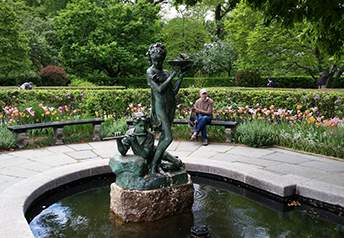
The Secret Garden by Bessie Potter Vonnah
First, let us enter the English garden, which was designed in 1936 as a memorial to Frances Hodgson Burnett 1849–1924), the British-American novelist and playwright best known as the author of three children’s novels: Little Lord Fauntleroy, A Little Princess, and The Secret Garden. Published in 1911, The Secret Garden’s child protagonists, Mary Lennox, an orphan, and her sickly cousin Colin live with Mary’s uncle in Misselthwaite Manor, a large private estate on England’s Yorkshire moors. Burnett’s plot centers around a hidden garden the two children discover and frequent, thereby making these playmates habitués of a small English country garden within a spacious landscape. Designed in 1936 by Bessie Potter Vonnah (1872-1955) an American sculptor best known for bronze statuary as ornamental elements within her fountain designs, The Conservatory Garden’s English-style garden featuring seasonal floral beds defined by low hedges and bluestone paths for perambulating visitors has a central water feature adorned by two bronze sculptures, one representing Mary and the other Colin, both of whom are poised on the rectangular slab atop a carved plinth at the south end of this small pool. Here Mary, who is portrayed as a graceful, lightly-clad girl, is raising aloft a shallow bowl into which a small fountain spout discharges water, forming an occasional birdbath, and Colin, who is playing a flute, reclines behind her next to the surface of the water-lily filled pool.
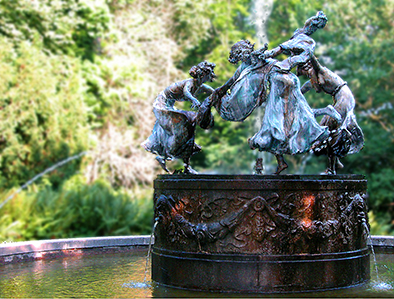
Untermyer Fountain by Walter Schott
On the opposite side of the Conservatory Garden from the English-style garden the twin parterres of the French garden are divided from one another by Walter Schott’s Untermyer Fountain, which is adorned by a bronze sculpture of a trio of dancing maidens holding hands with outstretched arms bathed by the spray from concealed spigots in the small pool atop the carved plinth supporting them. This fountain, which was given by the sons and daughters of Samuel and Minnie Untermyer, was transferred to its present location from the entrance to their parents’ estate facing the Hudson River in the city of Yonkers, a suburb of the New York metropolitan area, which is now a publicly accessible, comprehensively restored estate with several outstanding seasonally varied gardens and historic architectural features managed by a not-for-profit conservancy.
_
Here, with this fifth and final posting in the series “Central Park as an Outdoor Museum” we come to the end of our tour of statuary that constitutes the series of museum-worthy art works to be found in various locations within the park (one can think of these sites metaphorically as galleries). However, just as much as one cannot tire of admiring the grandeur of the park’s Manhattan schist outcrops, which are Nature’ own sculptural landmarks (and in several instances quarried building material), one cannot ignore the labor of the designers and laborers whose talents and physical brawn sculpted thousands of cartloads of imported soil, creating, amid the existing hills, valleys, streams, and marshes, the rest of the park’s topography. Neither can one not appreciate, as is evident in this journal posting, the works of other human hands and sensibilities that adorned the park with interpretive elements of historic and artistic interest. Like actual museums such at the Met, Central Park needs, and fortunately receives from the Central Park Conservancy, regular custodial care, cleaning, and conservationists’ repair of its bronze sculptures. Furthermore, also integrated into the park’s 830 acres, are pieces of artistic woodworking craftsmanship that deserve the same perennial attention that the bronze sculptures receive. Their original construction and current reconstruction and repair will be the subject of the next posting in this journal, which is dedicated to the men and women who built, rebuilt, and continue to rebuild the Central Park as a work of land art.
Share
